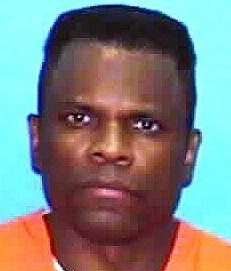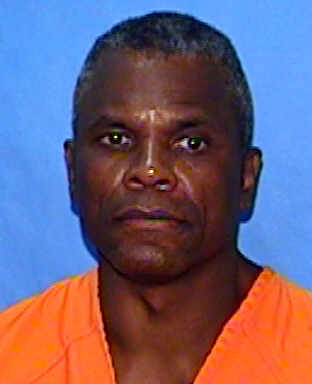On 07/27/77, John Ferguson, posing
as a Florida Power and Light employee, was let into a home by Margaret
Wooden to check the electrical outlets. After looking in several rooms,
Ferguson drew a gun, then bound and blindfolded Wooden. Ferguson let two
men, Marvin Francois and Beauford White, into the home to continue
searching for drugs and money. Two hours later, the owner of the home,
Livingston Stocker, and five friends returned home and were bound,
blindfolded, and searched by Ferguson, Francois, and White. The seven
bound and blindfolded people were then moved from the living room to a
bedroom.
Later, Wooden’s boyfriend, Michael Miller,
entered the house and was bound, blindfolded, and searched. Miller
and Wooden were moved to another bedroom together and the other six
men were moved to the living room. At some point in the evening,
Marvin Francois’ mask fell off and his face was revealed to the
others. Wooden heard shots coming from the living room, where
Francois was shooting the men. Ferguson placed a pillow over
Wooden’s head and then shot her. Not fatally wounded, Wooden saw
Miller being shot and heard Ferguson run from the room.
When the police arrived, they found six dead bodies,
all of which had their hands tied behind their back and had been shot in
the back of the head. Johnnie Hall survived a shotgun blast to the head
and testified regarding the execution of the other men in the living
room.
Codefendant Information: Ferguson, White, and
Francois were indicted together as coconspirators, but each was tried
separately. White was convicted on all counts of the indictment. The
jury recommended life imprisonment, but the judge sentenced him to
death. White was executed on 08/28/87. Francois was convicted on all
counts of the indictment. The jury recommended death sentences, and he
was sentenced to death. Francois was executed on 05/29/85. Adolphus
Archie, who drove the car used to drop off and pick up the shooters,
pled guilty to Second-Degree Murder and was sentenced to twenty years
imprisonment.
Trial Summary:
09/15/77 Indicted as follows: Counts I – VI
First-Degree Murder, Count VII Attempted First-Degree Murder, Count VIII
Attempted First-Degree Murder, Counts IX – XI Armed Robbery.
05/24/78 Jury returned acquitted verdict on Count XII
05/25/78 Jury returned guilty verdicts on Counts I –
XI of the indictment
Jury recommended death sentences by a majority vote
Sentenced as follows: Counts I – VI First-Degree
Murder – Death, Count VII - Attempted First-Degree Murder – 30 years,
Count VIII - Attempted First-Degree Murder – 30 years, Counts IX – XI -
Armed Robbery – Life imprisonment
Case # 78-05428
Date of Offense: 01/08/78
Date of Sentence: 10/07/78
Date of Resentence: 05/27/83
Circumstances of Offense: Brian Glenfeld and Belinda
Worley, both seventeen years old, were last seen around 9:00 p.m. on
Sunday, 01/08/78. The two were supposed to meet friends at an ice cream
parlor, but their bodies were discovered the next morning in a wooded
area. Glenfeld’s body was behind the wheel of a car, with gunshot wounds
to his chest, arm, and head. Worley’s body was found in a nearby dense
growth, where she had been raped and then shot in the head. Several
pieces of Worley’s jewelry were missing and cash was missing from
Glenfeld’s wallet.
On 04/05/78, John Ferguson was arrested at his
apartment pursuant to a warrant for unlawful flight to avoid
prosecution. At the time of the arrest, Ferguson was under indictment
for the six murders that occurred on 07/27/77 (case # 77-28650-D). After
a consent search of the apartment, in which a gun was recovered that was
similar to the gun used to kill Glenfeld and Worley, Ferguson admitted
to shooting the couple.
Trial Summary:
04/13/78 Indicted as follows: Count I First-Degree
Murder, Count II First-Degree Murder, Count III Armed Sexual Battery,
Count IV Armed Robbery, Count V Armed Robbery, Count VI Unlawful
Possession of a Firearm While Engaged in a Criminal Offense, Count VII
Possession of a Firearm by a Felon, Count VIII Possession of a Firearm
by a Felon.
10/07/78 Jury returned guilty verdicts on all counts
of the indictment (Count V was reduced to Attempted Armed Robbery by the
jury)
Jury recommended death sentences by a majority vote
Sentenced as follows: Count I First-Degree Murder –
Death, Count II First-Degree Murder – Death, Count III Armed Sexual
Battery – Life Imprisonment, Count IV Armed Robbery – Life Imprisonment,
Count V Armed Robbery – 15 year, Count VI Unlawful Possession of a
Firearm While Engaged in a Criminal Offense – 15 years, Count VII
Possession of a Firearm by a Felon – 15 years, Count VIII Possession of
a Firearm by a Felon – 15 years
Prior Incarceration History in the State of
Florida:
At the time of each of the murders, Ferguson was on
probation, having already served an eighteen month prison sentence for a
1976 conviction for Resisting a Police Officer with Violence. Ferguson’s
prior criminal history also included a 1971 Robbery conviction and a
1965 Assault with Intent to Rape conviction, for which Ferguson was
sentenced to ten years imprisonment.
Appeal Summary:
Florida Supreme Court – Direct Appeal (Case#
77-28650-D)
FSC# 55,137
417 So.2d 639
09/25/78 Appeal filed
07/15/82 FSC affirmed convictions, but remanded for resentencing
08/27/82 Mandate issued
Florida Supreme Court – Direct Appeal (Case#
78-05428)
FSC# 55,498
417 So.2d 631
11/13/78 Appeal filed
07/15/82 FSC affirmed convictions, but remanded for resentencing
08/27/82 Mandate issued
Florida Supreme Court – Direct Appeal (Consolidated)
FSC# 64,362 & 65,961
474 So.2d 208
10/10/83 Appeal filed
06/27/85 FSC affirmed death sentences
09/09/85 Rehearing denied
10/15/85 Mandate issued
Circuit Court – 3.850 Motion
CC# 77-28650-D & 78-05428
10/15/87 Motion filed
06/19/90 Circuit Court denied Motion
Florida Supreme Court – 3.850 Motion Appeal
FSC# 76,458
593 So.2d 508
08/10/90 Appeal filed
02/06/92 FSC affirmed denial of 3.850 Motion
02/26/92 Mandate issued
Florida Supreme Court – Petition for Writ of Habeas
Corpus
FSC# 80,549
632 So.2d 53
10/01/92 Petition filed
12/09/93 FSC denied Petition
02/24/94 Rehearing denied
U.S. District Court, Southern District – Petition for
Writ of Habeas Corpus
USDC# 95-573
03/20/95 Petition filed
05/15/00 USDC administratively closed case pending resolution of state
proceedings
08/07/01 Case reopened
11/02/01 Supplemental brief filed
09/26/03 Petition amended
05/19/05 USDC denied petition
Circuit Court – 3.850 Motion
CC# 77-28650-D & 78-05428
07/10/99 Motion filed
08/18/99 Circuit Court denied Motion
Florida Supreme Court – 3.850 Motion Appeal
FSC# 96,658
789 So.2d 306
01/27/00 Appeal filed
05/10/01 FSC affirmed denial of 3.850 Motion
06/11/01 Mandate issued
U.S. Court of Appeals, 11th Circuit – Petition for
Writ of Habeas Corpus Appeal
USCA# 05-13595
06/17/05 Appeal filed
08/26/09 USCA affirmed denial of Habeas
U.S. Supreme Court – Petition for Writ of Certiorari
USSC# 09-1186
03/31/10 Petition filed
06/01/10 Petition denied
Clemency Hearing: 03/10/87 Clemency hearing held
(denied)
Factors Contributing to the Delay in Imposition of
Sentence: The delay in this case appears to arise from the resentencing
of Ferguson and from the pending Federal Habeas Petition that was filed
on 03/20/95.
Case Information:
Ferguson filed a Direct Appeal (FSC# 55,137; CC#
77-28650-D) with the Florida Supreme Court on 09/25/78, citing the
following errors: unconstitutionality of the death penalty, failure to
provide written statements of support for the death penalty in the case,
improper prosecutorial comments during closing arguments, and admission
of prejudicial statements about Ferguson’s prior incarceration. On
07/15/82, the FSC affirmed the convictions, but vacated the death
sentences and remanded to the trial court for a new sentencing hearing,
finding that the trial court improperly weighed the aggravating and
mitigating circumstances in the case.
Ferguson filed a Direct Appeal (FSC# 55,498; CC#
78-05428) with the Florida Supreme Court on 11/13/78, citing the
following errors: unconstitutionality of the death penalty, failure to
suppress evidence, admission of evidence of the other murders, and
improper prosecutorial comments during closing arguments. On 07/15/82,
the FSC affirmed the convictions, but vacated the death sentences and
remanded to the trial court for a new sentencing hearing, finding that
the trial court improperly weighed the mitigating circumstances in the
case.
Ferguson was resentenced to death on 05/27/83.
Ferguson filed a Direct Appeal with the Florida
Supreme Court on 10/10/83, citing the following errors: failure to allow
an evidentiary hearing during resentencing; improper finding of the
cold, calculated, and premeditated murder aggravating circumstance; and
consideration of evidence not in the trial record. On 06/27/85, the FSC
affirmed the death sentence.
Ferguson filed a 3.850 Motion with the Circuit Court
on 10/15/87, which was denied on 06/19/90.
Ferguson filed a 3.850 Motion Appeal with the Florida
Supreme Court on 08/10/90, citing ineffective assistance of counsel and
improper jury instructions regarding non-statutory mitigating evidence.
On 02/06/92, the FSC affirmed the denial of the 3.850 Motion.
Ferguson filed a Petition for Writ of Habeas Corpus
with the Florida Supreme Court on 10/01/92, citing the following errors:
a different sentencing judge upon resentencing; vague jury instructions
regarding the heinous, atrocious, or cruel murder aggravating
circumstances; failure to grant a defense motion to stop giving Ferguson
anti-psychotic drugs; and ineffective assistance of appellate counsel.
The FSC denied the Petition on 12/09/93.
Ferguson filed a Petition for Writ of Habeas Corpus
with the U.S. District Court, Southern District on 03/20/95. On
05/15/00, the USDC administratively closed the case pending resolution
of state proceedings. On 08/07/01, the case was reopened, and on
11/02/01, Ferguson filed a supplemental brief with the court. On
09/26/03, Ferguson amended the Petition. The petition was denied on
05/19/05.
Ferguson filed a 3.850 Motion with the Circuit Court
on 07/10/99, which was denied on 08/18/99.
Ferguson filed a 3.850 Motion Appeal with the Florida
Supreme Court on 01/27/00, citing eleven issues, most of which focused
on claims of ineffective assistance of counsel and withholding of
evidence by the State. On 05/10/01, the FSC affirmed the denial of the
3.850 Motion.
Ferguson filed a Petition for Writ of Habeas Corpus
Appeal with the U.S. Court of Appeals, 11th Circuit on 06/17/05. The
District Courts denial of the Petition was affirmed by the U.S. Court of
Appeals on 08/26/09.
Ferguson filed a Petition for Writ of Certiorari with
the U.S. Supreme Court on 03/31/10. The petition was denied on 06/01/10.


